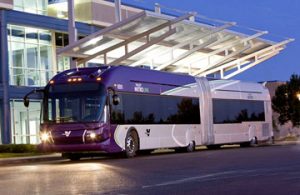By David A. Boggs

It is somewhat easy to understand why those sleek silver and purple buses that connect to METRO light rail service at Sycamore Station in Mesa, AZ, were upstaged on December 27, 2008.
With the much-celebrated grand opening of the new 20-mile light rail system, the new Valley Metro LINK bus rapid transit (BRT) service quietly began its own operations giving thousands of celebrants passage to the grand opening festivities at METRO’s most visited station.
Funded by public transportation funds, or Proposition 400, the revolutionary, state-of-the-art transit service offers a direct connection to the METRO light rail service from Superstition Springs Mall in east Mesa.
A solid partnership between the City of Mesa and Valley Metro helped make the project successful with the goal of providing an efficient and attractive way to travel. Ridership along the 12-mile route proves its success. Daily weekday ridership in March was 971, a 16 percent increase in ridership over February. Each weekday the LINK bus fleet can take nearly 7,000 cars off of the roads. It’s catching on — and we think we know why.
Valley Metro purchased the 63-ft low-floor New Flyer articulated buses with the agency’s updated paint scheme specifically to serve the route and to complement the new METRO vehicles. Riders feel good about taking the LINK.
Fueled by ultra-low sulfur diesel technology, the buses are efficient and green. Particulate traps capture soot and dirt particles from the exhaust. The air-conditioning system uses 407c Freon, an environmentally friendly refrigerant tested for keeping its cool in the heat of an incredibly hot summer afternoon in Mesa.
Low-energy LED interior lighting helps further reduce energy use and offers a cooling effect. The seat fabric incorporates advanced technology that recycles plastic water bottles. Windows glazed gray reduce light transmission by 23 percent.
One bus seats 55 people and can accommodate at least half of that standing. Doing the math, it carries the same number of passengers as two 40-ft buses can, but requires fewer natural and man-made resources and reduces capital costs with one fewer operator required.
Not only are the buses beautiful, a LINK Bus is also powerful. Even with every seat occupied it still has enough reserve power to tow a fully grown African elephant, which weighs between 9,000 and 13,000 pounds.
So, it is not surprising that LINK offers rail-like comfort and speed. The system is a potential pre-cursor to a METRO extension to the current 20-mile system that will extend the service farther into downtown Mesa.
There are two wheelchair positions and a non-skid bus ramp to help those who are traveling in wheelchairs, scooters or other personal mobility devices. Three wide-glide doors offer quicker entry and exit, which also helps speed the bus along.
LINK’s top testament to greater speed is with traffic signal prioritization—or extending green lights as it travels through intersections. New bus stations are currently under construction and will complete the service as they open in October 2009. Stations will be equipped with next bus notices and technology that includes scrolling dynamic message signs.
The bus stations along Main Street and Power Road will feature unique structures that provide a maximum of shade with a minimum of visual obstruction. Many raised platforms will make boarding easier — particularly for handicapped riders.
These stations will also have a distinctive design with an integration of lighting to provide a halo effect in the evening hours, without illuminating the nighttime sky.
The next stop for LINK is service beginning July 2010 serving Chandler, Gilbert and Mesa along Arizona Avenue (Chandler) and Country Club Road (Mesa). It’s just one more step in the regional transit system.
David A. Boggs, serves as executive director, Valley Metro, Phoenix, AZ.
